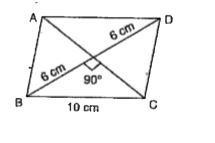The perimeter of a rhombus is 40 cm. If one of the diagonals be 12 cm long, what ia the length of the other diagonal ?
12 cm
√136cm
16 cm
√44cm
The correct Answer is:C
To find the length of the other diagonal of the rhombus, we can follow these steps:
Step 1: Understand the properties of the rhombus
A rhombus has all four sides equal, and its diagonals bisect each other at right angles.
Step 2: Calculate the length of one side
Given the perimeter of the rhombus is 40 cm, we can find the length of one side (s) using the formula for the perimeter:
Perimeter=4×side
Setting this equal to 40 cm:
4s=40
Dividing both sides by 4:
s=10 cm
Step 3: Use the properties of the diagonals
Let the diagonals be d1 and d2. We know that one diagonal d1=12 cm. The diagonals bisect each other, so each half of the diagonals will be:
d12=122=6 cm
Let the other diagonal d2 be unknown, so:
d22=x cm
Step 4: Apply the Pythagorean theorem
In the right triangle formed by the halves of the diagonals and a side of the rhombus, we can apply the Pythagorean theorem:
s2=(d12)2+(d22)2
Substituting the known values:
102=62+x2
Calculating the squares:
100=36+x2
Step 5: Solve for x2
Rearranging the equation to isolate x2:
x2=100−36
x2=64
Step 6: Find x
Taking the square root of both sides:
x=√64=8 cm
Step 7: Calculate the length of the other diagonal
Since x is half of d2:
d2=2x=2×8=16 cm
Final Answer
The length of the other diagonal d2 is 16 cm.
---
A rhombus has all four sides equal, and its diagonals bisect each other at right angles.
Given the perimeter of the rhombus is 40 cm, we can find the length of one side (s) using the formula for the perimeter:
Perimeter=4×side
Setting this equal to 40 cm:
4s=40
Dividing both sides by 4:
s=10 cm
Let the diagonals be d1 and d2. We know that one diagonal d1=12 cm. The diagonals bisect each other, so each half of the diagonals will be:
d12=122=6 cm
Let the other diagonal d2 be unknown, so:
d22=x cm
In the right triangle formed by the halves of the diagonals and a side of the rhombus, we can apply the Pythagorean theorem:
s2=(d12)2+(d22)2
Substituting the known values:
102=62+x2
Calculating the squares:
100=36+x2
Rearranging the equation to isolate x2:
x2=100−36
x2=64
Taking the square root of both sides:
x=√64=8 cm
Since x is half of d2:
d2=2x=2×8=16 cm
The length of the other diagonal d2 is 16 cm.
Topper's Solved these Questions
- BOOK - KIRAN PUBLICATIONCHAPTER - MENSURATIONEXERCISE - TYPE -II386videos
MENSURATION
- BOOK - KIRAN PUBLICATIONCHAPTER - MENSURATIONEXERCISE - TYPE - III21videos
MENSURATION
- BOOK - KIRAN PUBLICATIONCHAPTER - LCM AND HCF EXERCISE - Test Yourself18videos
LCM AND HCF
- BOOK - KIRAN PUBLICATIONCHAPTER - MISCELLANEOUSEXERCISE - TYPE-VI15videos
MISCELLANEOUS
Similar Questions
the perimeter of a rhombus is 60 cm.If one of its digonals is 18 cm long find (i) the length of the other diagonal , and (ii) the area of the rhombus.
View SolutionThe perimeter of a rhombus is 40 cm. If the length of one of its diagonal is 10 cm, what is the length of the other diagonal?
 View Solution
View Solution
Knowledge Check
- Question 1 - Select One
The perimeter of a rhombus is 40 cm. If the length of one of its diagonals be 12 m, then the length of the other diagonal is
A14 cmB15 cmC16 cmD12 cm - Question 2 - Select One
The perimeter of a rhombus is 20 cm. The length of one of its diagonal is 6 cm. What is the length of the other diagonal ?
A6 cmB9 cmC8 cmD10 cm
The side of a rhombus is 13 cm. if one if the diagonals is 24 cm, find the length of the other diagonal.
View Solutionthe perimeter of a rhombus is 180 cm and one of its diagonals is 72 cm find the length of the other diagonal and the area of the Rhombus
View SolutionThe length of one side of a rhombus is 13 cm and one of the diagonals is 10 cm. What is the length of the other diagonal?
View SolutionThe perimeter of a rhombus is 164 cm. If the length of one of the diagonals is 18 cm, find the length of ither diagonal. Hence, find the area of the rhombus
View SolutionThe area of a rhombus is 148.8cm2. If one of its diagonals is 19.2 cm, find the length of the other diagonal.
View SolutionEach side of a rhombus is 10cm. If one of its diagonals is 16cm find the length of the other diagonal.
View Solution

